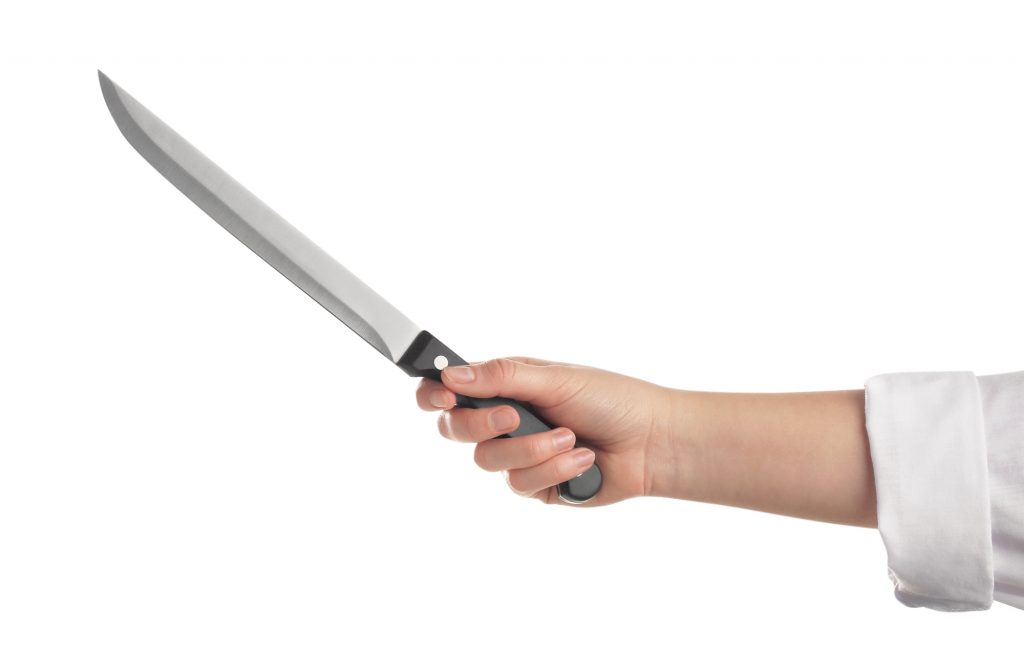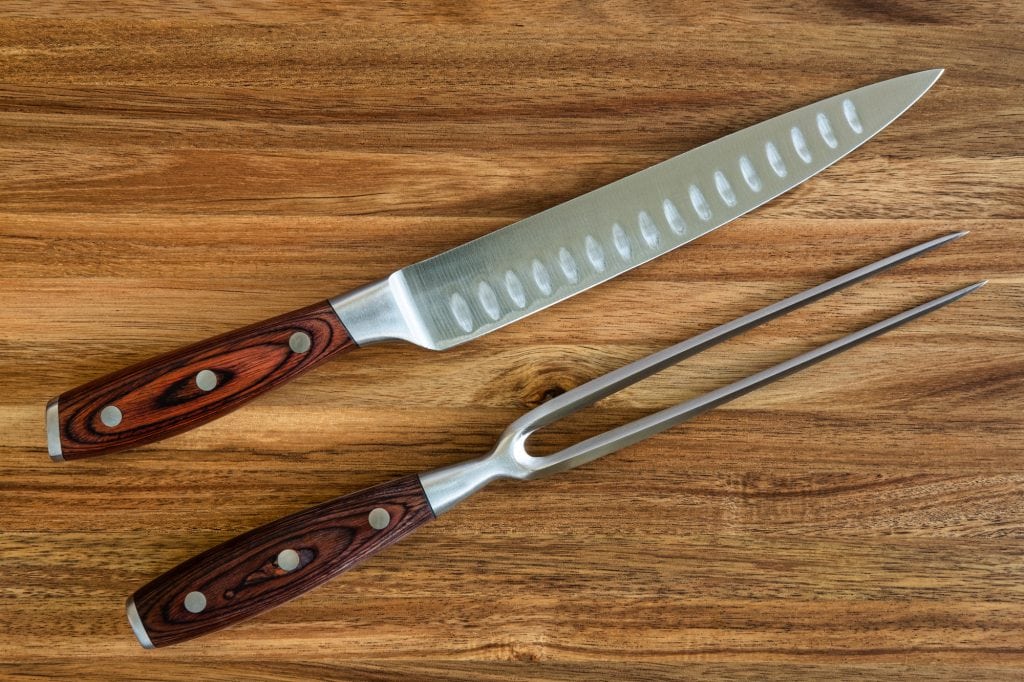From Thanksgiving dinner to separating a delicious roast for a family meal, having a well-made carving knife improves your kitchen capabilities by a lot. A quality carving knife is the reason you see those incredible photos of perfectly separated pork loins or medium-rare pan-seared steaks on social media. That is why we thought it a good idea to offer a robust buying guide. You are always welcome to skip over to our List of the Best Carving Knives to see examples of what we think is good or use our buying guide to make your own selection.
How to Choose the Best Carving Knife for You?
Every person is different, and personal preference plays a significant role in what type of carving knife you will end up purchasing. Our goal is to help you with the critical buying decision factors that will elevate your ability to select a carving knife solution for your home. Keep in mind the type of meals you enjoy cooking and your kitchen lifestyle as you learn more about carving knives from our buying guide.
What is a carving knife?
Carving knives are designed for intricate slicing through dense meats. You are creating uniform slices of different meats. When you think of a carving knife, think of carving the turkey around Thanksgiving or slicing up a Sunday roast, as we mentioned before.
What does a carving knife look like?
There are two main types of carving knives that you will see for sale. The first is more like a slicing knife with a long blade leading to a sharp tip at the end for working around bones. The more traditional carving knife is a thin, long straight blade with subtle dimples along the edge to prevent the meat from sticking to the sides as you slice. These have more rounded blade tips and are not taller than a couple of fingers held together.
What is a carving knife used for?
The primary reason to own a carving knife is to get those mouth-watering slices from a freshly cooked piece of meat. These are not slicing knives. Even though they are similar, slicing knives have a slightly different shape with a rounded tip and are not intended for working with larger meats like turkeys. You can learn more about the differences from our article Slicing Knife vs. Carving Knife.
Carving knives are primarily used for cutting through large pieces of meat in tandem with a long two-pronged fork to hold the meat in place. They are not typically used for working with fruits or vegetables.
Good For:
- Poultry like turkey, pheasant, duck
- Roasts
- Hams
- Large steaks
Not Good For:
- Detail work
- Smaller fruits or vegetables
Your decision comes down to what feels the most comfortable to you. Here are a few considerations to keep in mind when making your next carving knife purchase.

Price – How Much Does a Carving Knife Cost?
As carving knives are essential for many households celebrating big holiday or weekend events, they tend to be a more premium blade than everyday use knives. That is also why they have one of the wider price ranges. You can expect to pay anywhere from $20 to more than $400 for a premium set. However, price does not always dictate quality either. It depends on how often you use the blade and what size of meat you are cutting.
Are carving knives worth it?
If you are a home with frequent big dinners or lunches involving large pieces of meat, then a carving knife is essential. They make the process of breaking down turkeys, chickens, loins, roasts, and more a lot easier. They also allow you to improve your meals’ overall presentation, which your family and guests will appreciate.
Dimensions – The Length & Weight of a Carving Knife
A carving knife has two fundamental dimensions to consider while buying – the overall length and the weight. These matter so much because you are working with larger pieces of meat and need a bit more leverage to get a uniform set of slices. If your blade is too small or light, you cannot work as well with the meal you are serving.
The length of a carving knife
Most carving knives will come in a range of 8 to 14 inches in length. The goal is to find a length that is longer than the largest item you plan to be slicing. For example, you would not want to use a short blade on Thanksgiving. You also do not want a knife that makes you uncomfortable to use because it is too long.
What is the best length for a carving knife?
We always recommend first-time buyers shoot for a 10-inch blade. This is the most versatile and can handle a small to medium-sized turkey. It may seem strange to keep using Thanksgiving references in this buying guide, but that imagery really helps cement the idea of what a carving knife is used for and how long it should be.
The weight of a carving knife
Carving knives are weighed in ounces or grams, depending on what store or online site you are shopping. The goal is to find a blade around 6 to 10 ounces. Weight matters because you want the blade to be heavy enough to do most of the work of slicing for you. Otherwise, you will be stuck sawing your meat which leads to frayed edges and unattractive presentation.
What is a good weight for a carving knife?
We suggest a total weight of between 8.2 and 9.1 ounces. This seems to be heavy enough to handle most small to medium-sized birds without feeling like you are lifting a dumbbell while you slice.
The Carving Knife’s Blade

The blade of a carving knife is crucial because you need an edge that will slice evenly through large meats. That requires a lot of sharpness and durability, so you will not have to resharpen after each use. Carving knives have long, thin blades, so there is less resistance to slicing. The tip may be sharp in some cases but traditionally is rounded. The knife’s body often includes dimples, sometimes called grantons, that also reduce resistance as you slice through the meat so it will not stick to the side of the blade.
What is the difference between forged and stamped blades for a carving knife?
Almost all knives will have a designation on their profile describing if they are forged or stamped. A forged blade is made from a single piece of steel or other material in a much more personalized process. A stamped blade is made from a sheet of metal, usually by machine. They both have their advantages, but a forged blade will generally be of higher quality than a stamped blade.
Blade material – What material should the carving knife blade be made of?
A lot of blades on the current market are a blend of different materials. Producers are trying to find that perfect balance of durability and sharpness, so testing and research play into what a carving knife will be made of when you go searching. Here are some of the more common materials:
- Carbon – usually blended carbon and iron made into an incredibly strong blade that stays sharp for a long time. The only downside is that these will rust if left in water for too long.
- Stainless Steel – An excellent modern material to keep your blade safe from rust and other contaminants but does not hold its sharpness as well as carbon.
- Laminated or Damascus Steel – One of the more premium materials on the list because it ends up with these fantastic wavy lines on the blade body. This tends to be harder than other materials because it combines alloys.
- Ceramic – another premium material that results in a sharp and light blade made from zirconium oxide. Not always the best a carving knife because you want more weight in the blade.
- Titanium – this is a preferred material for cooks and chefs working with seafood because it holds up well in saltwater. Again, not the best for carving knives unless you can get a good weight.
Blade flexibility – Should a carving knife have a flexible blade?
Yes and no. You want a little flexibility to work with poultry as that often involves getting around complicated bone structures, but a more rigid blade is preferred for hot, roasted meats. Sticking to a medium flexibility is your best bet unless you are buying a set of carving knives for a restaurant.
Blade Width/Thickness – How thick should a carving knife blade be?
Most blades will be measured in mm or inches and lean toward the thinner side. You want those delicious uniform slices, and that requires a precision blade width instead of something thicker. We encourage you to go for a 0.35 to 0.45 thickness for your carving knife.
Tang
The tang refers to whether or not the metal of the blade extends into the construction of the hilt/handle. The longer the tang, the more durable the blade because you won’t have that separation point between where you are applying pressure and the end of the blade. We prefer a full or at least partial tang in our carving knives.
HRC
This refers to the overall hardness rating of the blade material. You want a sweet spot where the blade is hard enough to retain its edge for a long time but not too hard that it becomes brittle under environmental temperatures or conditions. A carving knife should be between 55-58 HRC, but we have seen some 62 blades that have been cryogenically treated.
Edge profile – What edge should a carving knife have?
The edge of your carving knife will determine how well you actually slice through different meats. The sharper the edge, the less work you have to do and the more uniform you can make each piece of meat. There are three main types of edges:
- Convex Bevel – slightly rounded edge that tapers off to a fine point.
- Single Bevel – one side of the edge is angled, creating a chisel-like what you would see in a sushi restaurant for fine slicing with fillet knives.
- Double Bevel – this is the best for carving knives because it is a v-shape with two angles on either side of the blade.
The Carving Knife’s Handle
The size and comfort of a carving knife handle are critical to the user because you do not want to slip with this blade. While the edge may not be as sharp as other kitchen knives, it is often long enough to cause severe damage. Try to find an ergonomic blade handle that fits well into your hand and easily maintains your grip.
We always recommend sticking to a metal or alloy handle that can be maintained easily. You are working with a lot of meat when using a carving knife, and you do not want any remnants to remain after use that can lead to bacterial growth.
Balance
A carving knife needs to balance just after the bolster meets the blade on the blade side. This tells if the knife is well-made and versatile enough to give you an even cutting opportunity. If the weight is too far on the handle, you will have to work harder to get the cut you want.
Maintenance and Care – How to Maintain a Carving Knife?

Maintenance is critical to your carving knife. You want the blade to keep its edge profile and avoid any rust that can damage the overall knife. This requires simple steps that ensure your blade will be around to enjoy for years to come.
Learn how to remove rust from a knife blade and how to protect your kitchen knife from rusting.
How to clean a carving knife?
The good news is that carving knives are pretty easy to keep clean. You hand wash them using a little soap and hot water and then completely dry them off before putting them away. You need to take extra care to ensure they are completely dry, as water is the greatest threat to most blade materials.
Are carving knives dishwasher safe?
No. The extreme heat can warp the blade, and many homeowners leave their dishwashers to air dry, which means the blade is exposed to water for a longer duration. That can lead to rust.
Honing & sharpening your carving knife – How to keep your carving knife sharp?
The difference between sharpening and honing your carving knife is that sharpening removes some of the metal to create a new edge while honing reforms the already present metal. We strongly encourage you to purchase sharpening steel that you can use in the vertical position to reform the edges of your carving knife. There are many sets of blades you can purchase that include honing steel.
Read now >> How to test sharpness?
How to store a carving knife?
As carving knives are frequently used for special events, holidays, or big family dinners, they tend to come in cases that can be reused for storage. If you do not have that option, be sure to have a large enough woodblock or sheath to protect little hands from the blade. While this may not be as sharp as a fillet knife, it can cut through fingers.
Conclusion
Getting a quality-made carving knife is critical for any household hosting Thanksgiving dinner or cooking up delicious pieces of large meats. Using a carving knife together with a meat fork is an excellent choice to maintain control, so you do not accidentally hurt yourself. Stick to a decent length and weight, and you should be more than happy with your purchase. You will be carving up that Sunday roast in no time!
